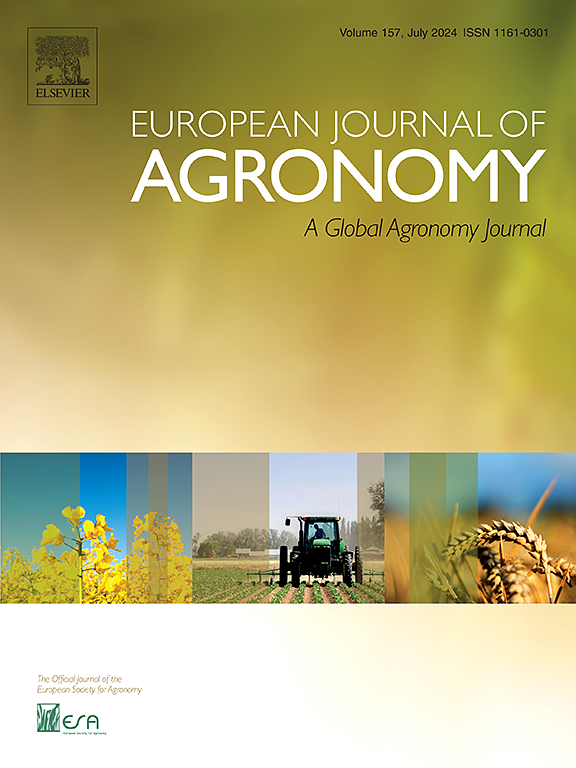Responsive root traits and mitigating strategies for wheat production under single or combined abiotic stress
IF 4.5
1区 农林科学
Q1 AGRONOMY
引用次数: 0
Abstract
The frequency of abiotic stress impairing wheat root growth and yield production has been increasing with global warming. Diverse root traits have been widely targeted to improve wheat adaptivity to different abiotic stress, but most research has been conducted under controlled environments with a single stress factor, hindering transferability to fields conditions with multiple stresses. It is essential to distinguish the valuable root traits for both individual and combined abiotic stresses, and identify agronomic practices that can mitigate the detrimental effects on wheat production. This review summarizes morphological, physiological and anatomical root traits of wheat under stresses of drought, soil compaction, nitrogen (N) and phosphorus (P) deficiency, and waterlogging. Variations of root traits are further discussed under the co-occurrence of these abiotic stresses. In general, thick wide-angle seminal roots, deep sparse roots, and lengthy laterals roots are superior root traits under the stress combinations of drought combined with either soil compaction, N deficiency, or P deficiency. Dense adventitious, thin and sparse roots, and lengthy laterals with aerenchyma formation are superior root traits under the stress combinations of waterlogging combined with either soil compaction, N deficiency, or P deficiency. Wheat production loss from multiple stress conditions can be relieved by optimal crop and soil management strategies, including fertigation and subsurface drainage. Future development of wheat production should focus on taking advantage of adaptative root traits and agronomic optimization.
单一或综合非生物胁迫条件下小麦生产的根系响应性状和缓解策略
随着全球变暖,影响小麦根系生长和产量的非生物胁迫频率不断增加。为了提高小麦对不同非生物胁迫的适应性,人们广泛地瞄准了不同的根系性状,但大多数研究都是在单一胁迫因子的受控环境下进行的,这就阻碍了研究成果在多种胁迫的田间条件下的应用。必须区分单独和综合非生物胁迫下有价值的根系性状,并确定可减轻对小麦生产不利影响的农艺措施。本综述总结了小麦在干旱、土壤板结、缺氮(N)、缺磷(P)和涝害等胁迫下的根系形态、生理和解剖特征。还进一步讨论了在这些非生物胁迫同时存在的情况下根系性状的变化。一般来说,在干旱与土壤板结、缺氮或缺磷的胁迫组合下,粗大的广角精根、深的稀疏根和长的侧根是根系的优良性状。在涝害与土壤板结、缺氮或缺磷的胁迫组合下,密集的不定根、稀疏的细根和有气孔形成的长侧根是优良的根系性状。通过优化作物和土壤管理策略,包括施肥和地下排水,可以缓解多重胁迫条件对小麦产量造成的损失。小麦生产的未来发展应侧重于利用根系的适应性和农艺优化。
本文章由计算机程序翻译,如有差异,请以英文原文为准。
求助全文
约1分钟内获得全文
求助全文
来源期刊

European Journal of Agronomy
农林科学-农艺学
CiteScore
8.30
自引率
7.70%
发文量
187
审稿时长
4.5 months
期刊介绍:
The European Journal of Agronomy, the official journal of the European Society for Agronomy, publishes original research papers reporting experimental and theoretical contributions to field-based agronomy and crop science. The journal will consider research at the field level for agricultural, horticultural and tree crops, that uses comprehensive and explanatory approaches. The EJA covers the following topics:
crop physiology
crop production and management including irrigation, fertilization and soil management
agroclimatology and modelling
plant-soil relationships
crop quality and post-harvest physiology
farming and cropping systems
agroecosystems and the environment
crop-weed interactions and management
organic farming
horticultural crops
papers from the European Society for Agronomy bi-annual meetings
In determining the suitability of submitted articles for publication, particular scrutiny is placed on the degree of novelty and significance of the research and the extent to which it adds to existing knowledge in agronomy.
 求助内容:
求助内容: 应助结果提醒方式:
应助结果提醒方式:


